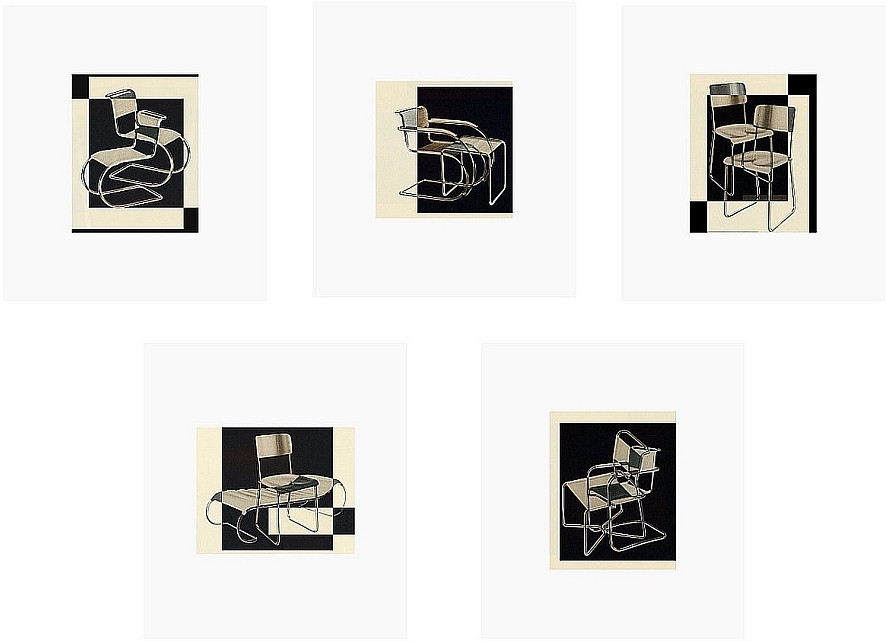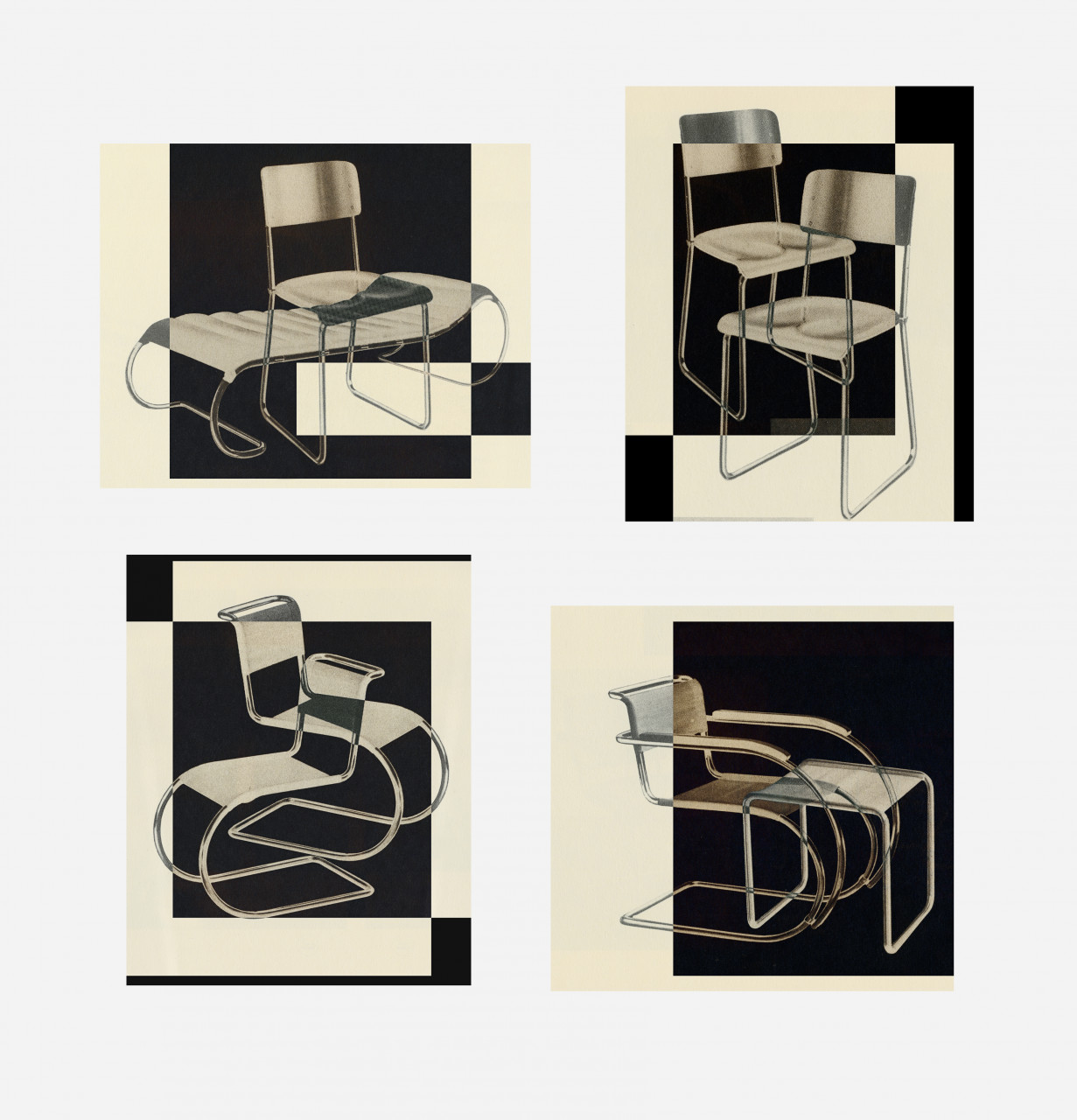Thomas Ruff and Jörg Schellmann – 35 Years
We have had the honour and pleasure of supporting Thomas Ruff on his editions journey from the very beginning. Since 1988, we have published over 150 works together and collaborated on the artist's catalogue raisonné Thomas Ruff – Editions 1988 - 2014, cataloguing his entire print oeuvre. The second, updated edition of this catalogue is freely accessible as a digital database at arspublicata.com
After 35 years as Thomas Ruff's main publisher, we are now joining forces with the artist's gallery David Zwirner to co-publish his editions, starting with our newest release, d.o.pe.
This portfolio of digital pigment prints is based on Thomas Ruff's most recent body of work, d.o.pe. series, which was exhibited at David Zwirner New York in October 2022. Known for his exploration of the ever-changing possibilities of photography and his interest in visualised geometric structures (coined "fractal" by the mathematician Benoît Mandelbrot in 1975), Thomas Ruff used a specialised software programme to create fractal patterns which were then printed on industrial carpets for the exhibition, and on rag paper for the edition.
The title of the series refers to Aldous Huxley’s autobiographical volume The Doors of Perception from 1954.
2023
Four digital archival pigment prints on Hahnemühle Photo Rag Ultrasmooth 305g/qm paper
Vertical works: 70 x 55 cm (27.5 x 21.7 in), horizontal work: 70 x 100 cm (27.5 x 39.5 in)
Edition of 40 + 5 AP, signed and numbered
Co-published by Schellmann Art and Utopia Editions
Set EUR 9,000
Vertical works EUR 2,200 each
Horizontal work EUR 3,300

2019
Set of 6 digital pigment prints (Ditone) on Hahnemuehle Rag paper, each 55 x 65 cm (21¾ x 25½ in). Edition of 33, each signed and numbered on verso.
Set EUR 9,000
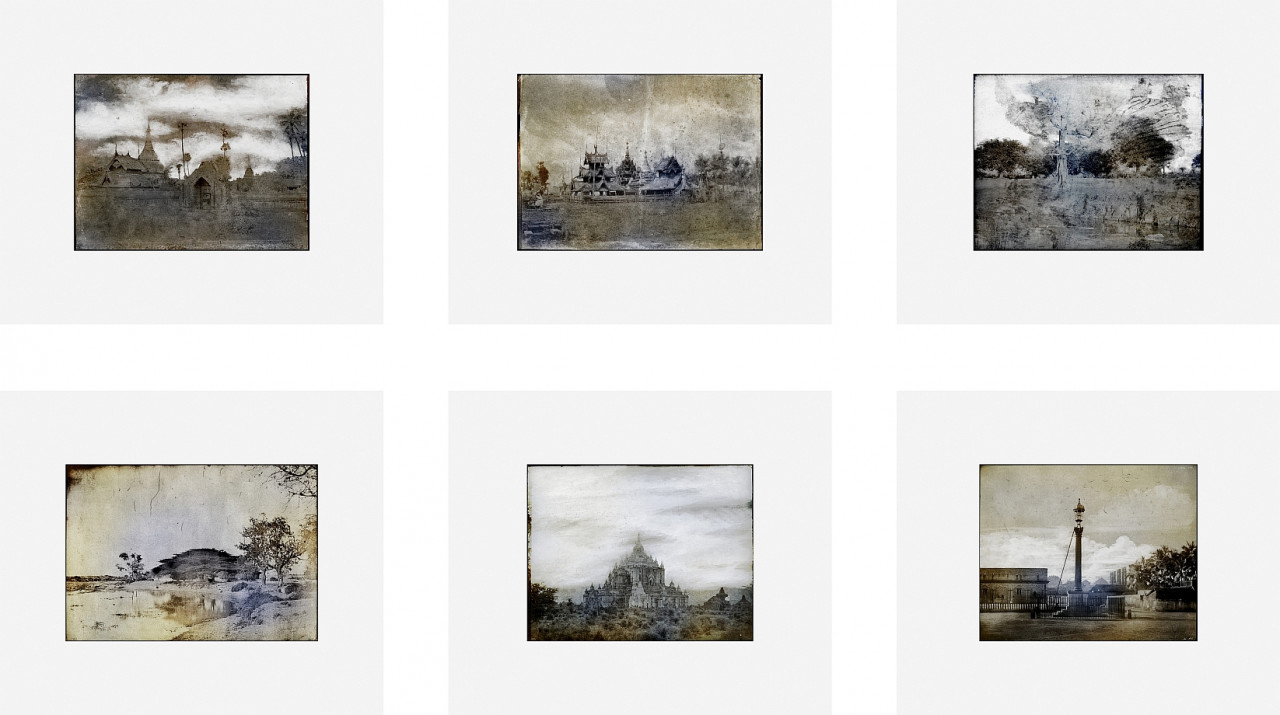
Tripe | The starting point for the Tripe series were paper negatives, which Captain Linnaeus Tripe (1822-1902) had produced on behalf of the British government in Myanmar and Madras between 1856 and 1862 and which are now in the archives of the Victoria & Albert Museum in London.
Thomas Ruff was able to view the surviving negatives in the format 30.5 x 38 cm and selected several of these for his own work. All of them showed clear signs of aging; some were damaged by mold, water, or chemical changes. In many of them, the thin layer of wax that had been applied to make the paper more transparent showed clear signs of creasing or breaking. Ruff had the negatives digitally reproduced and then converted them into positives, inverting the brownish hue of the negative to a cyan blue. He duplicated these positives and changed the colour of the duplicates to the brown tone of the negatives. He superimposed the two positive images as digital layers and removed parts of the layer of the brownish image so that the coloration of the bluish layer partially shines through. In a second step, he enlarged the images so that the texture of the paper and all the processing, damage, and changes became visible.
2018
Fujiflex, mounted on aluminum (Dibond). 24 images, different sizes from 21 x 23 to 21 x 30.8 cm (8¼ x 9 to 8¼ x 12 in). Edition of 15 each, signed and numbered on verso, on stand.
All images are available individually.
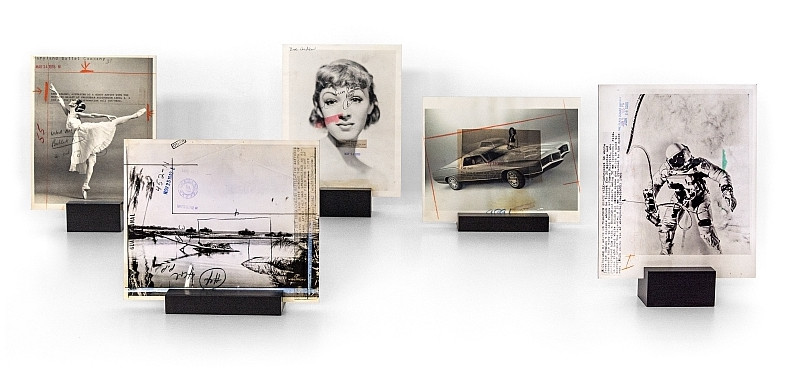
press++ | Ruff’s source material for press++ comprises press photographs from the 1930s to the 1980s, originating primarily from the archives of American newspapers and magazines. The artist scanned the front and back sides of the original documents and superimposed the image with the content appearing on its verso. This material includes handwritten records of the subjects’ names, instructions on how to print the photograph, agency stamps, scrawled dates, the yellowed remains of adhesive tape, retouched areas, ink stains, and fingerprints.
2016
Digital pigment print on rag paper, 70 x 100 cm (25½ x 39½ in). Edition of 40, signed and numbered on verso.
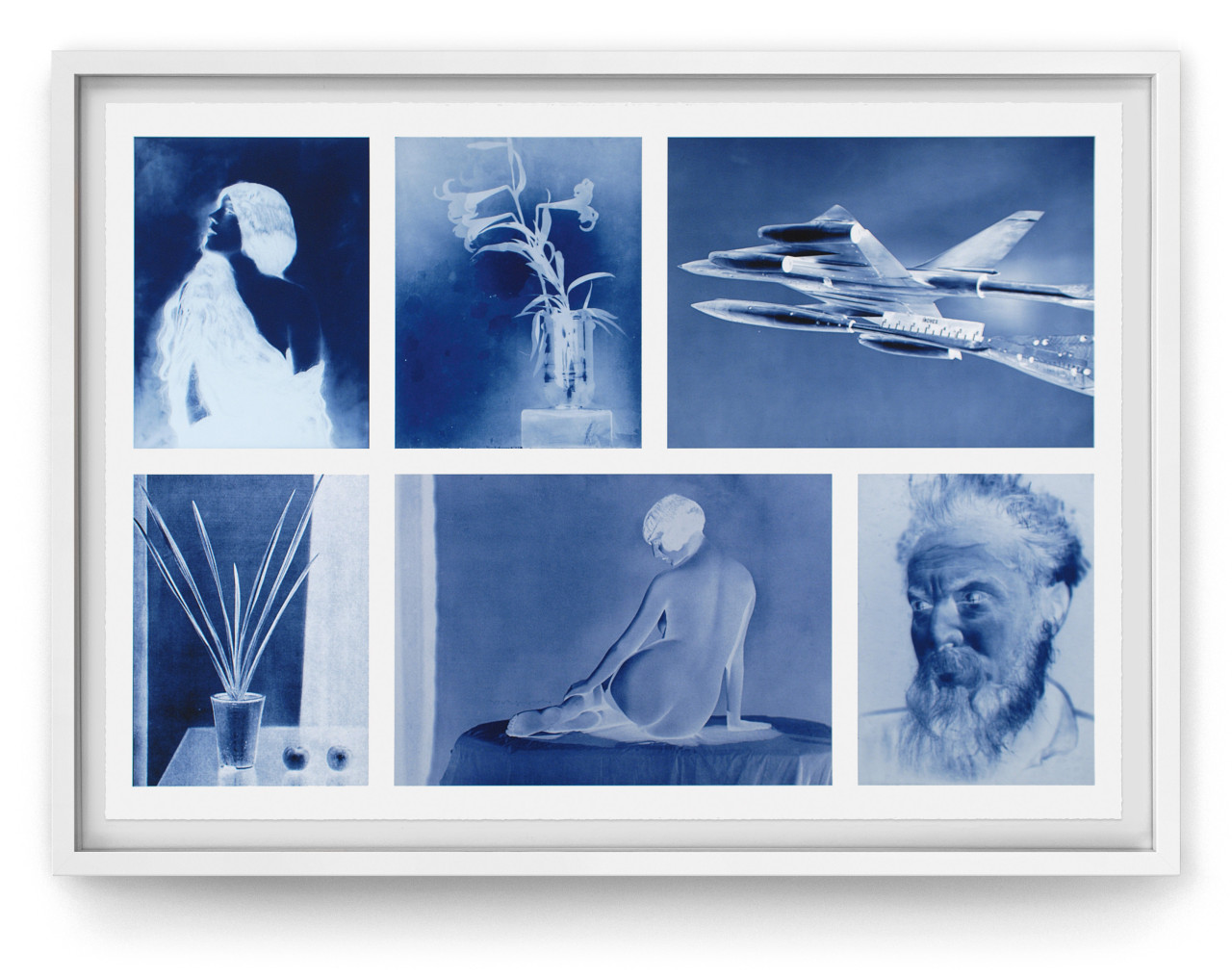
Digital pigment print, on rag paper, 70 x 100 cm (25½ x 39½ in). Edition of 40, signed and numbered on verso.
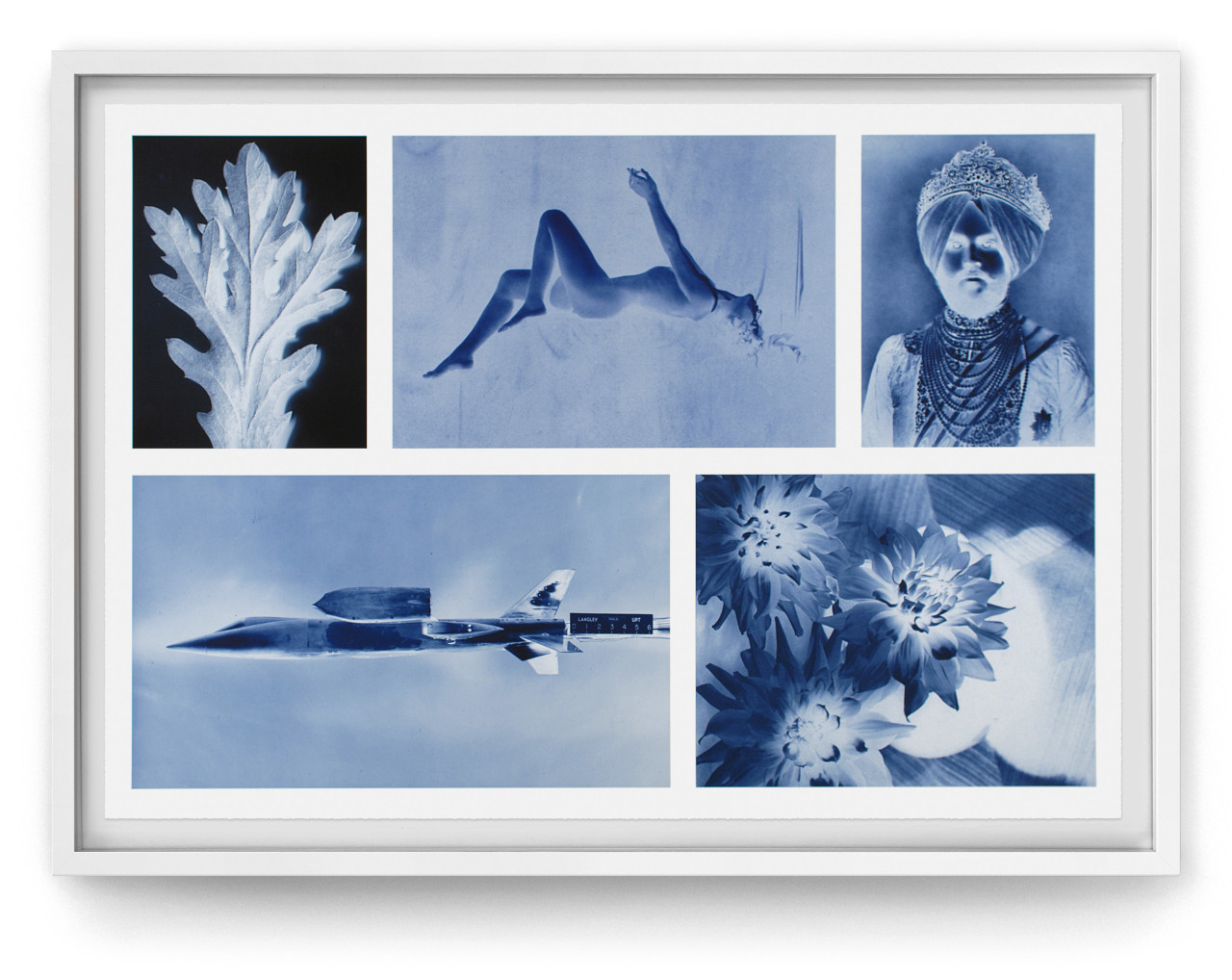
Negatives | Around 2014, Thomas Ruff began to intensify his studies of the visual appearance of the source material of printed analogue photography: the "negative". To visualise the photographic reality and pictorial qualities, he transformed historical photographs into digital negatives. In the process, he not only changed the light-dark distribution in the image, but also turned the brownish hue of the photographs printed on albumin paper into a cool, artificial blue tone. The aim of this process was to highlight the photographic negative, which in analogue photography was never actually the object of contemplation, but rather only a means to an end. In this series, it is treated as an "original" worth viewing, from which a photographic print is made and which, due to digital photography, is in danger of disappearing completely.
2014
Five chromogenic color prints, mounted on aluminum board (Dibond), each 74 x 58 cm (29 x 23 in). Edition of 40, each signed and numbered on verso.

phg (Photograms) | Fascinated by photograms from the 1920s, Thomas Ruff decided to explore the genre and develop his own contemporary version of these camera-less photographs. To circumvent the limitations of analogue photograms, he used a virtual darkroom to create a simulation of the direct exposure of objects on light-sensitive paper. He would lay objects (lenses, rods, spirals, paper strips, spheres, and other things) generated by a 3-D programme on or over a sheet of digital paper, correct their position and, in some cases, expose them to coloured light. This made it possible to control the projection of the objects on the background in the virtual space and print the image rendered by the computer in any size he wanted. In this way, he succeeded in transferring the idea and aesthetics of the pioneers of the "camera-less photography" of the 1920s to generate images with light into the twenty-first century using a technique appropriate to his own time.
Set of three digital pigment prints (Ditone) on semi-transparent polyester foil; left and right image 100 x 76.7 cm each, center image 100 x 80 cm (39½ x 30¼ or 39½ x 31½ in). Edition of 15, each signed and numbered.
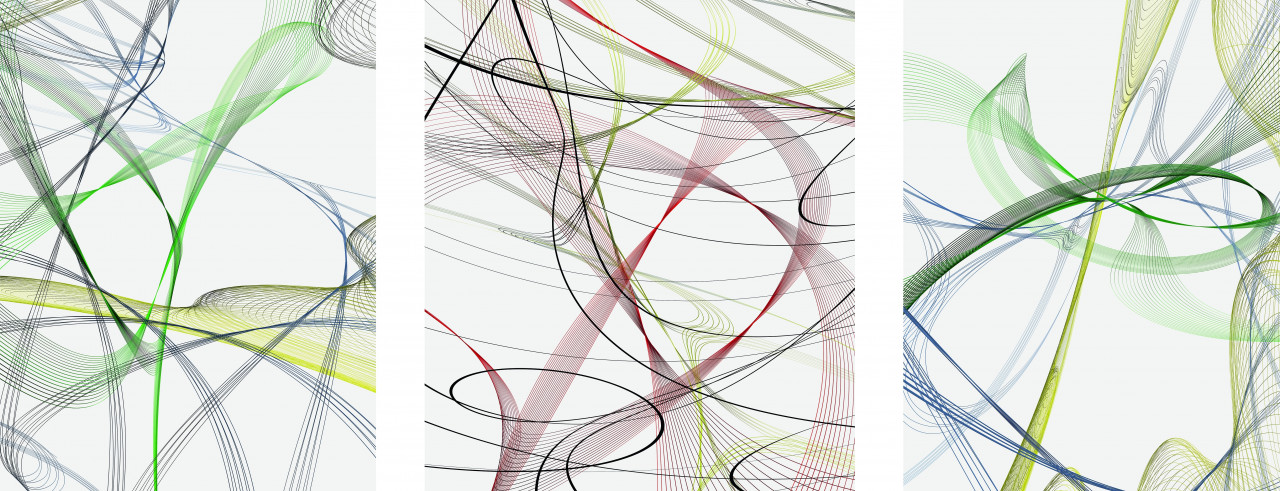
zycles | The zycles series was inspired by antiquarian books on electromagnetism that Ruff had purchased, including one by British physicist James Clerk Maxwell, which was illustrated with copper-point engravings of magnetic fields. These fine patterns of lines reminded Ruff of abstract drawings and minimal art. Wondering how such drawings could look in three-dimensional space, he started playing with a 3-D computer programme for the visualisation of complex formulae from linear algebra in the 2-D and 3-D space. Using the mathematic formulae for various cycloids (which are viewed in mathematics as "the most aesthetic curves"), Ruff created virtual complex 3-D line structures and took various close-up shots in a way that one can no longer discern their origin in mathematics.
2012
Portfolio of six C-prints, each 84 x 60 cm (33 x 23¾ in). Edition of 40, each signed and numbered.
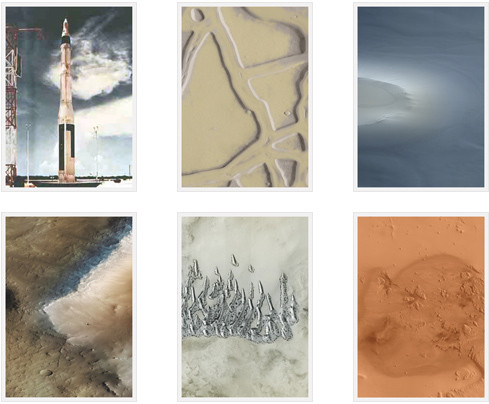
ma.r.s. | While conducting research on images from outer space, Thomas Ruff came across photos of Mars taken from 2006 onwards using a HiRISE (High Resolution Imaging Science Experience) camera, which is on board the Mars Renaissance Orbiter launched by NASA in August 2005 and transmits via satellite detailed images of the surface of the planet Mars to Earth. Ruff processed these very naturalistic and yet strange images, intended to provide scientists with more precise knowledge of the surface, atmosphere and water distribution on Mars, in several steps: Among other things, he transformed the black-and-white images, which were photographed vertically downwards into views from an angle, and then added colour in such that the surface of the distant planet appears immediately accessible and almost familiar.
2010
Set of 3 digital pigment prints (Ditone) on photo rag paper, 85 x 68 cm (33½ x 26¾ in) each. Edition of 30, each signed and numbered on verso.
Set EUR 6,000
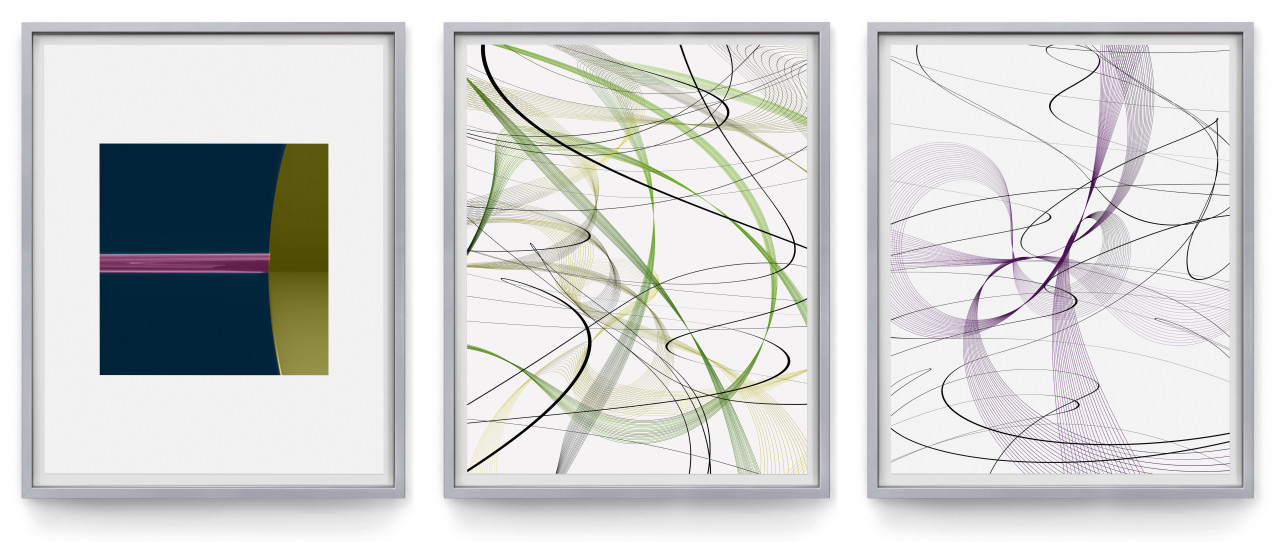
cassini | In 2008, Ruff's great interest in astronomy and scientific images from outer space led him to turn his attention to photographs of Saturn and its moons. Since 2005, the images have been transmitted to Earth by the Cassini space probe, launched by NASA in October 1997 – and have been available online, free of charge. Ruff chose a number of the images from the great range at hand and then processed them on a computer. He changed the colour tones and substantially enlarged the relatively small images. The intention behind the colouring was to enhance the abstract quality of the scientific "images of nature".
2009
From Forty Are Better Than One
8-part leporello, digital pigment print (Ditone) on 260 g Hahnemühle Baryta paper, 32 x 200 cm (12½ x 78¾ in). Edition: 75, signed and numbered.

Set of four digital pigment prints (Ditone) on semi-transparent polyester foil, 70 x 122, 70 x 114, 70 x 62 and 70 x 54 cm (27½ x 48, 27½ x 45, 27½ x 24½ and 27½ x 21 in). Edition of 15, each signed and numbered.
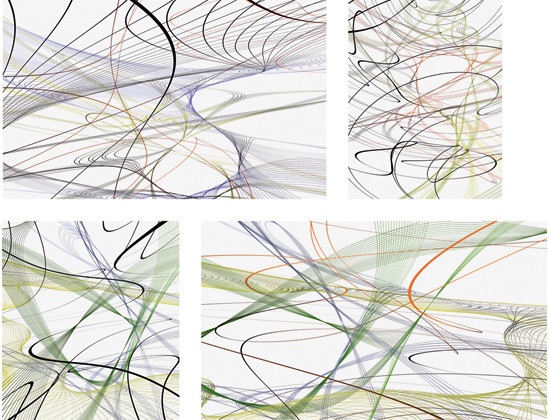
2008
Portfolio of 7 digital pigment prints (Ditone) on photo paper, 90 x 120 cm (35½ x 47¼ in). Edition of 45, signed and numbered.

jpeg | The visual starting point of the jpegs are images that are distributed worldwide through the Internet, as well as scans of postcards and illustrations from photo books. The artist is interested in the digital geometrical structure of images, which forms the basis of the JPEG format. This standard compression format breaks the pixel structure down into image squares of 8 x 8 pixels during the storage process, whereby each image square is compressed independently of the others and simplified according to specific rules. When the image information reduced in this way is displayed enlarged, the respective group of pixels becomes visible as a square block in a grid. This is actually a mistake that is perceived as disturbing; for Thomas Ruff, however, it is a fascinating artifact that can heighten the viewer's perception. By intensifying the pixel structure and simultaneously enlarging the overall image, the artist creates new images, which, seen up close, resemble a geometric colour pattern, but become photographic images when viewed from a greater distance. By using the entire range of images published and discussed globally in recent decades, he makes the series almost a visual encyclopedia of the world of media images and a reflection of its characteristics determined by the medium.
2005
Published for the 51st Venice Biennale
Lambda C-print, 45 x 60 cm (17¾ x 23¾ in). Edition of 60, signed and numbered.
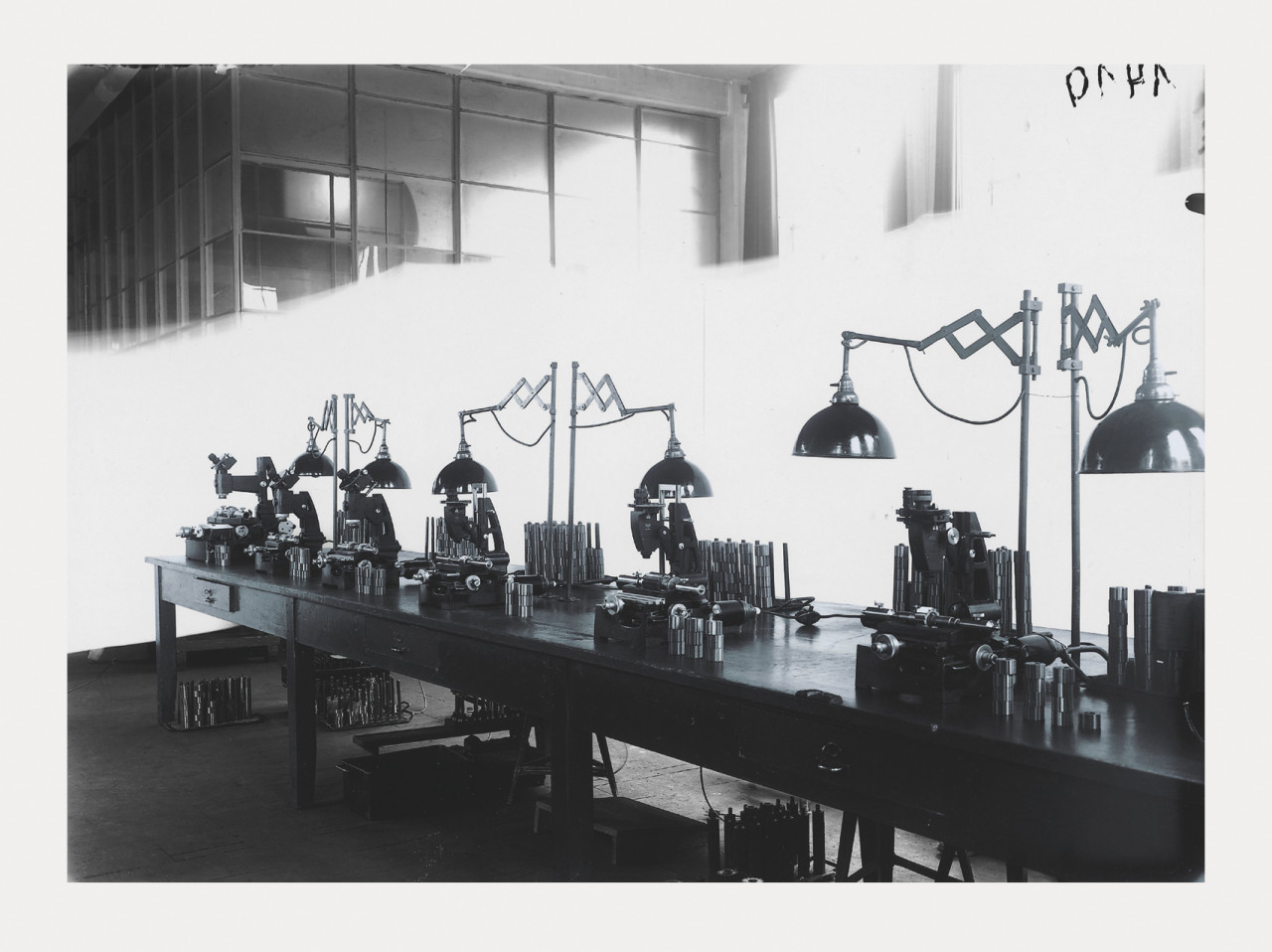
Set of 8 digital pigment prints on photo rag paper, 50 x 40 (15¾ x 19¾ in) and 40 x 50 cm (19¾ x 15¾ in), respectively. Edition of 30, each signed and numbered.
Set EUR 7,500
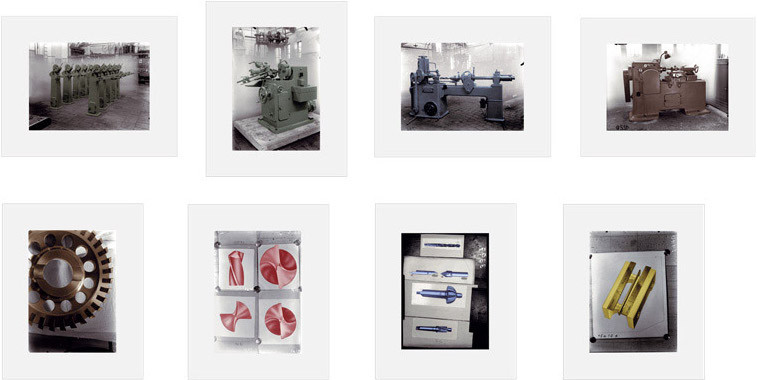
Machines | In 2000, Thomas Ruff acquired several boxes containing roughly 2,000 glass negatives dating from the 1930s. They constituted the image archive of the former Rohde & Dörrenberg company in Düsseldorf-Oberkassel which manufactured machines and machine parts. The photos were originally produced for the company catalogue and presented its entire product line. In order to make it easier to cut out the object in question, which back then was done by hand, the products tended to be photographed on their own against a white background; the print was then retouched and further processed for printing. Ruff emphasised this extremely elaborate preparation and image processing – the analog counterpart of digital processing with "Photoshop" – by colouring individual areas of the digitised images with purposefully set colours, similar to retouching.
Set of 5 digital pigment prints (Ditone) on photo paper, 120 x 90 cm (47¼ x 35½ in) each. Edition of 45, each signed and numbered on verso.
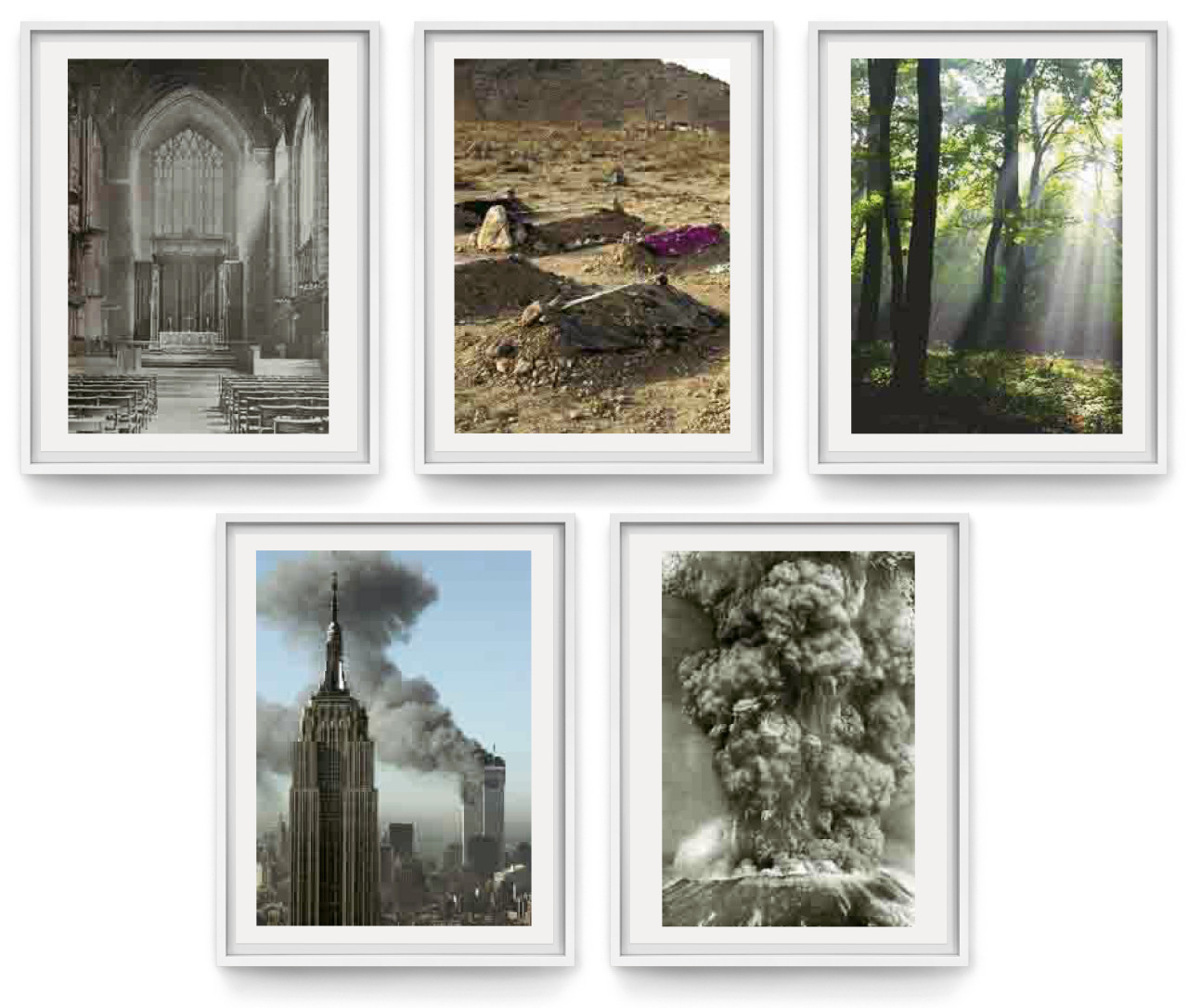
2004
Set of 6 C-prints mounted on aluminum (Dibond), 58 x 70 cm (23 x 27½ in), each signed and numbered. Edition of 40, in aluminum box.
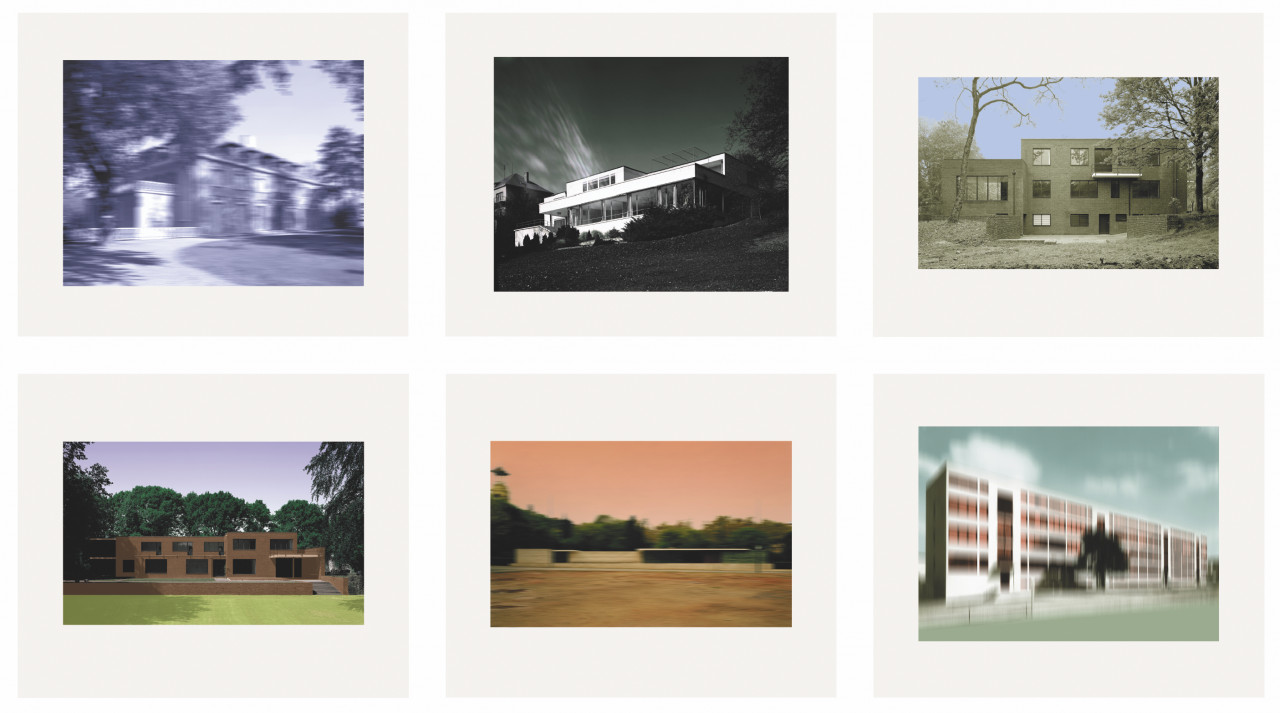
l.m.v.d.r. | In 1998, Julian Heynen, at the time curator at the Kunstmuseen Krefeld, asked Thomas Ruff to prepare an exhibition with architectural photos of the villas Ludwig Mies van der Rohe had designed between 1927 and 1930. Ruff tried to find his own way of seeing and photographing the various buildings, relying on all the techniques he had used to date. During the show in Krefeld, Terence Riley (The Museum of Modern Art, New York), who was preparing a retrospective on Mies van der Rohe's architecture through 1938, approached Ruff and asked him to photograph all the other Mies van der Rohe buildings from the period existing in Europe for the exhibition. Since some of the buildings could not be photographed, Ruff also made use of already existing image material, which he processed digitally.
2003
Suite of 4 Ditone prints on 250 g satin paper, mounted on aluminum board (Dibond), each print 100 x 75 cm (39½ x 29½ in), signed and numbered. Edition of 45.

Substrates | While searching for image material for the nudes series, Ruff noticed that the virtual images on the Internet essentially no longer represented reality but were merely visual stimuli conveyed by purely electronic means. The flood of images online, where images and information get superimposed, hardly allow the viewer an opportunity to determine what is real and what is virtual. Ruff set out to penetrate this terrain of visual "nothingness" using his experience in digital image processing. To this end, he used comic images as the material, superimposing these in several layers and multiplying them with one another until he had an image that was more or less devoid of meaning, thus creating his well-known substrates series.
2002
From Double Exposure
Two C-prints, mounted on Forex, 59 x 42 cm (23¼ x 16½ in) each. Edition of 45, signed on both images.
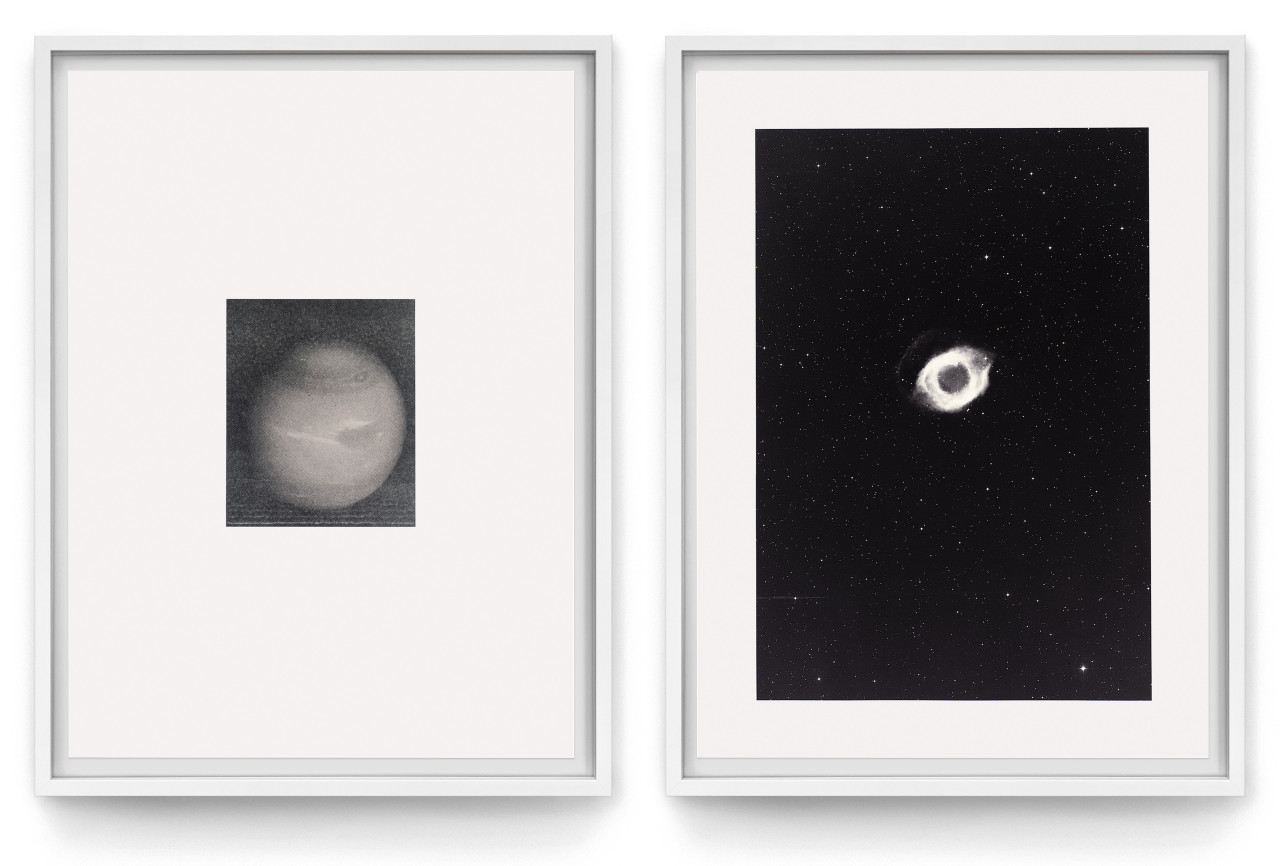
2001
Set of 8 Iris prints on rag paper, each print 75 x 60 cm (29½ x 23½ in), each signed and numbered on verso. Edition of 50.
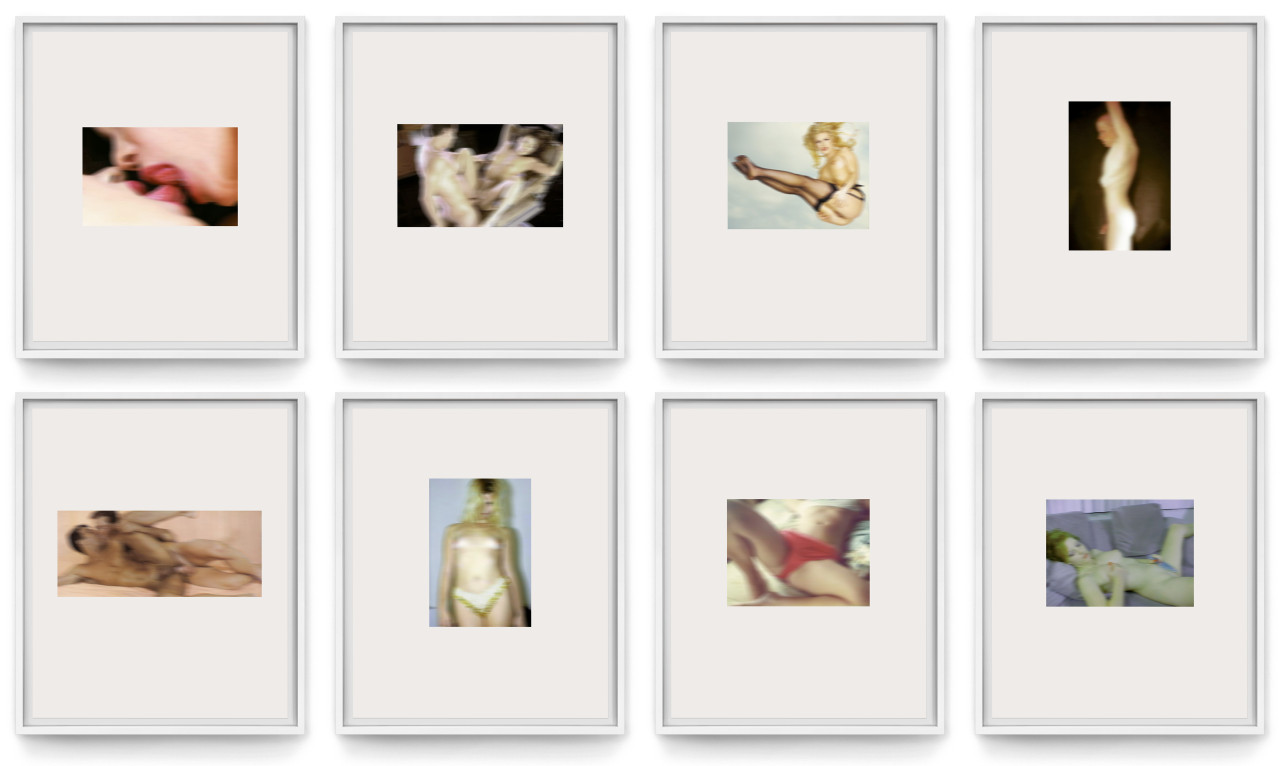
nudes | Around 1998, Thomas Ruff began to work on nude photography and, at the same time, began experimenting with computer-generated, abstract pictures made of pixels. Through Internet research into the genre of nude photography, he came across the field of pornography and the disposable images of "thumbnail galleries" online. Due to the poor resolution (72 dpi), they had a rough pixel structure, which resembled the one he had been experimenting with for abstract pixel images. He decided to process them in such a way that the pixel structure was only just barely visible when enlarging the images but changed them by using fuzziness and other blurring techniques, modifying the colouring and removing intrusive details. By doing so, he lent the "obscene" images a painterly appearance and focused on the structure and composition of the image. The selection of source images was based on such considerations as image format, lighting, colouring, or presentation, as well as the desire to cover the wide range of present-day sexual fantasies and practices.
1998
From Sequences
Two grano lithographs on Fabriano rag paper. Each print 50 x 40 cm (19¾ x 15¾ in), each signed and titled, edition of 60.
Set EUR 900
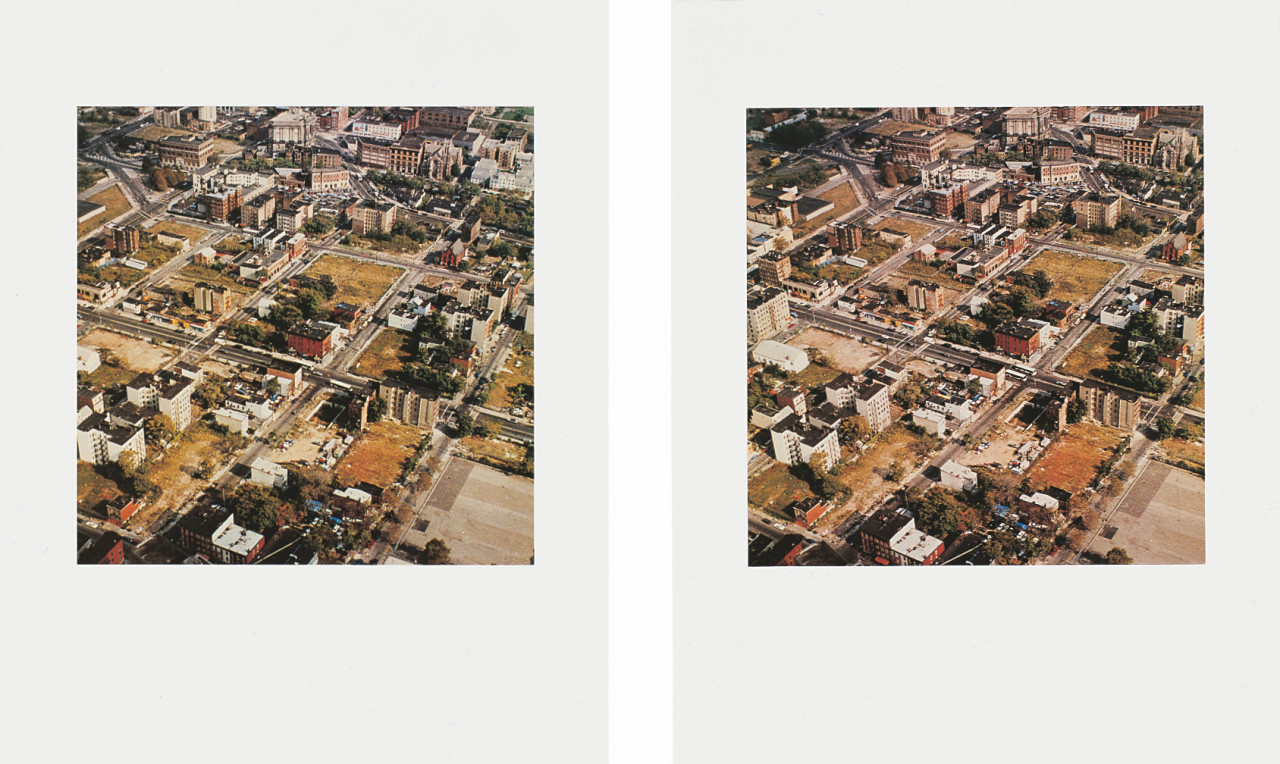
1996
2 silkscreens, each print 72 x 104 cm (28 x 40 in), each signed and numbered. Edition of 40 + X + 10 A.P.
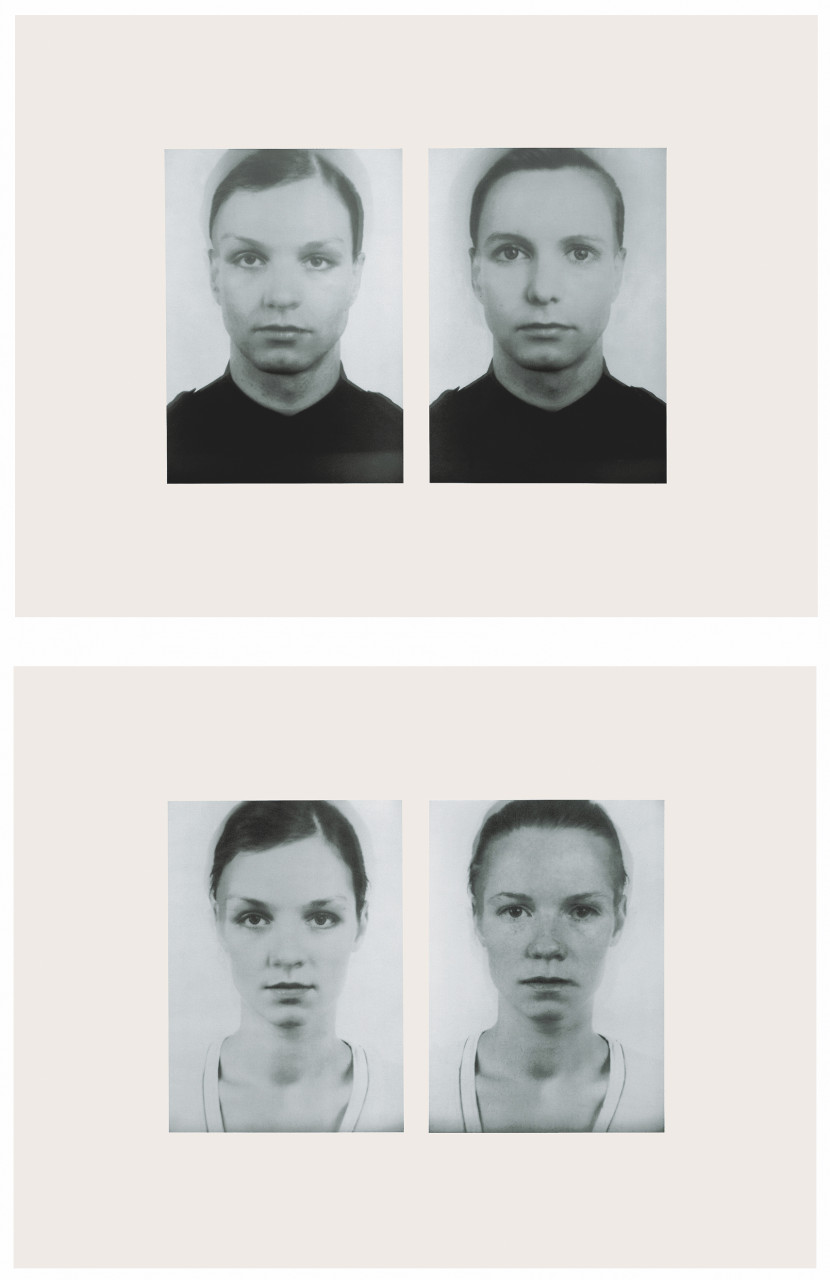
Other Portraits | In 1992, while conducting research into "composite faces", Ruff came across the so-called Minolta Montage Unit, an image-generating device used by several German State Criminal Police Offices in the 1970s in order to create identikit images. The device uses mirror optics to splice four portrait photos into a single new portrait. While Ruff had hitherto tried to reconstruct faces, he now found it more interesting to construct artificial faces not taken from reality but nevertheless conceivable. He wanted to address this type of image manipulation, which recurs repeatedly throughout the history of photography (be it by double exposure, retouching, various darkroom techniques, or now with digital image processing) without actually using one of the techniques in question. The idea was for the image to arise before the camera and to be recorded in a single shot. Ruff therefore borrowed such a device from the Polizeihistorische Sammlung (Police History Collection) in Berlin and combined two of his own portrait photos in each case to create a new portrait. He then photographed the new image made in this way and used the slide as the basis for the silkscreen.
1993
Set of 5 grano lithographs, each print 71 x 74 cm (28 x 29 in), each signed and numbered on verso. Edition of 45.
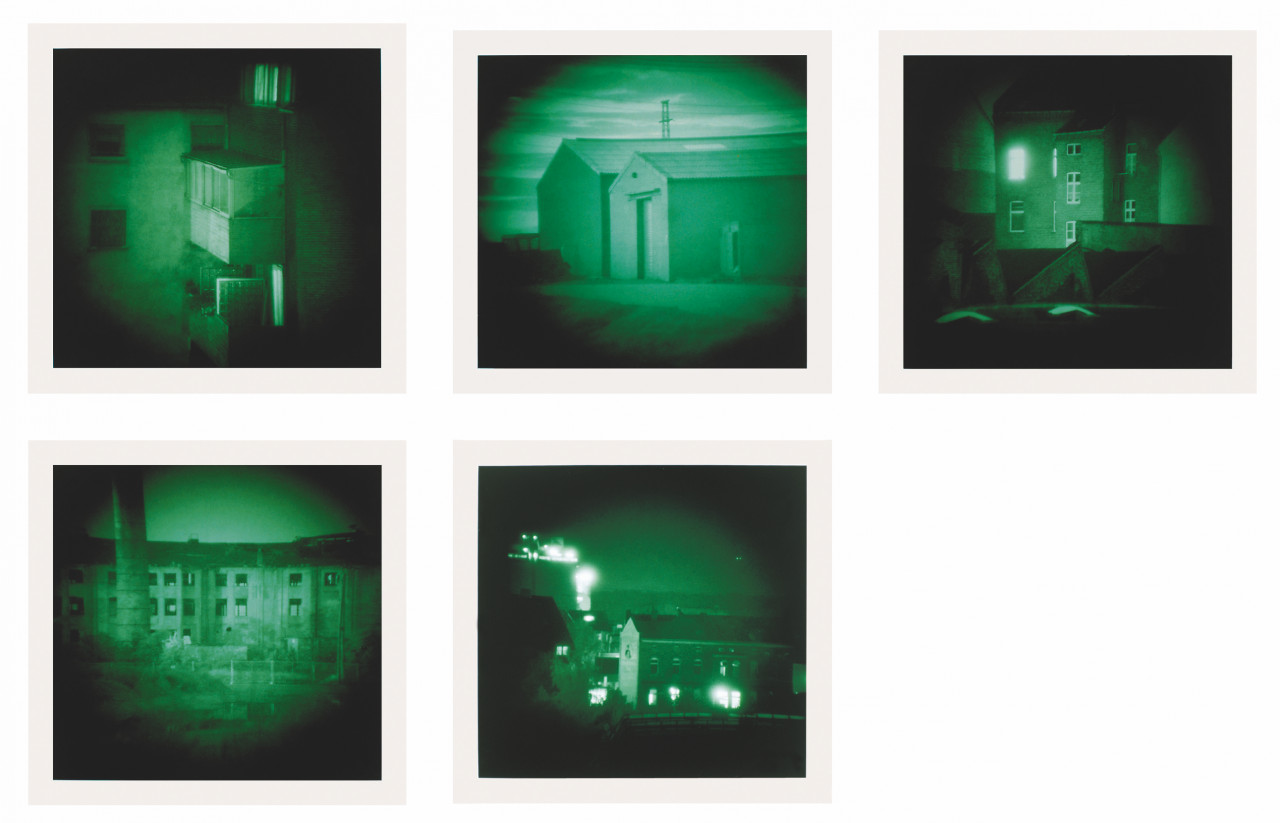
Nights | Night pictures of events during the Gulf War (1990-1991), broadcast on various television channels, awakened Thomas Ruff's interest in night vision devices. Originally developed for military purposes, the device captures occurrences at night in a greenish light with the help of a light intensifier. Fascinated by the technique and the possibility of making the "invisible" visible, Ruff acquired a light intensifier for his camera and began taking pictures of backyards and streets in Düsseldorf environs. Later, he extended his nocturnal studies to other cities.
1991
Portfolio of 24 offset/silkscreen prints, 50 x 40 cm (19½ x 16 in) each. Edition of 36, signed and numbered on verso on five prints of the portfolio.
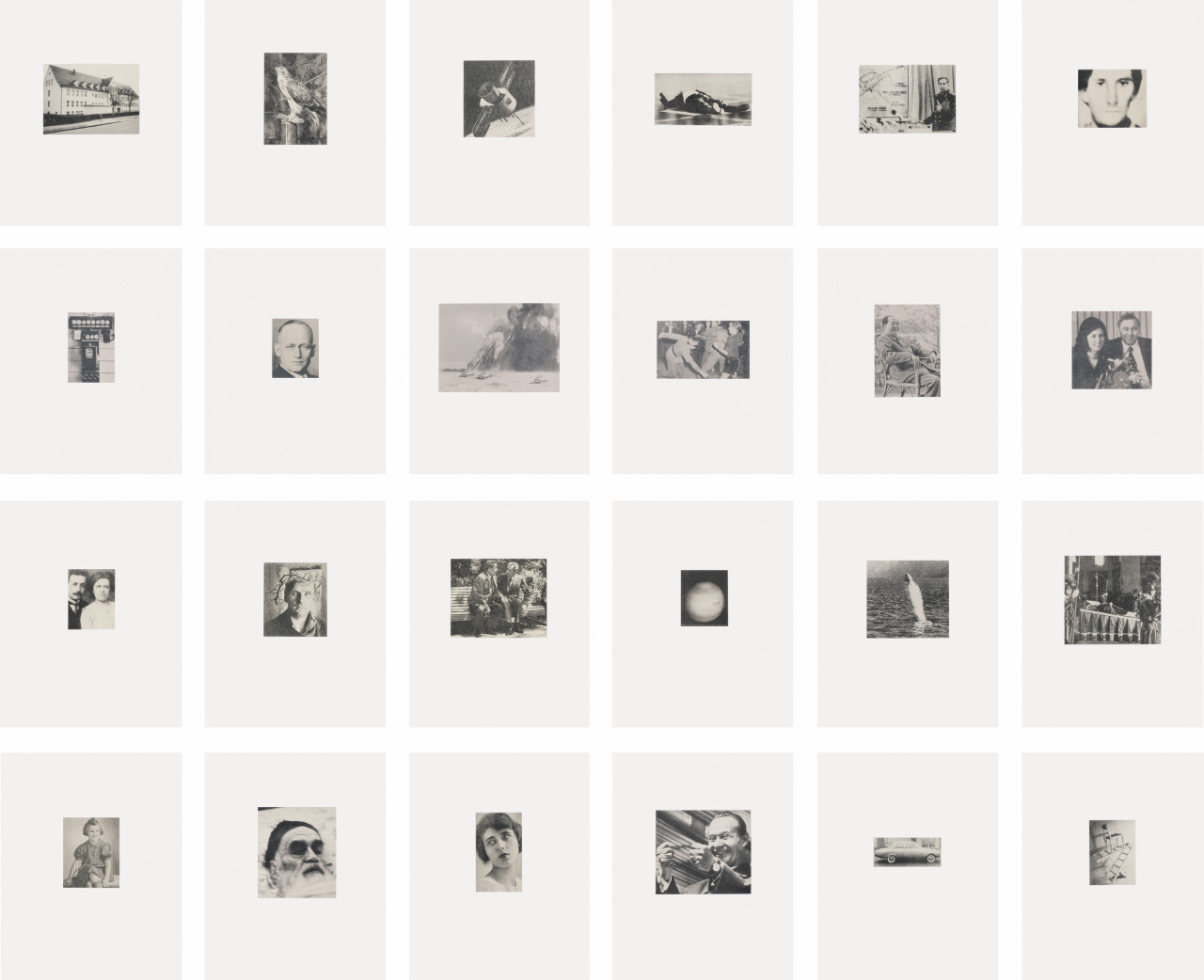
Newspaper Photos | Between 1981 and 1991, Thomas Ruff collected over 2,500 newspaper photographs from German-language dailies and weeklies. They are pictures that interested him or struck him as odd in some way. They cover all aspects of newspaper reportage: politics, finance, sports, culture, sciences, technology, history, and current events. The motifs reflect a kind of collective visual world of a specific generation. To be printed in the newspapers, the images were not chosen according to artistic criteria but rather by editorial considerations with the aim of illustrating a news story. Ruff narrowed his "archive" down to a selection of 400 images, which he had reproduced and printed in double column width (at a scale of 2:1) with no words of explanation. He settled on this procedure in order to focus on the appearance of the Newspaper Photos and to question what information is left when the image is isolated from its function.
1990
Portfolio with eight grano-lithographs on Ikonorex 300g card stock, varnished, 89.5 x 65 cm (35¼ x 25½ in). Edition of 40, each signed and numbered on verso.
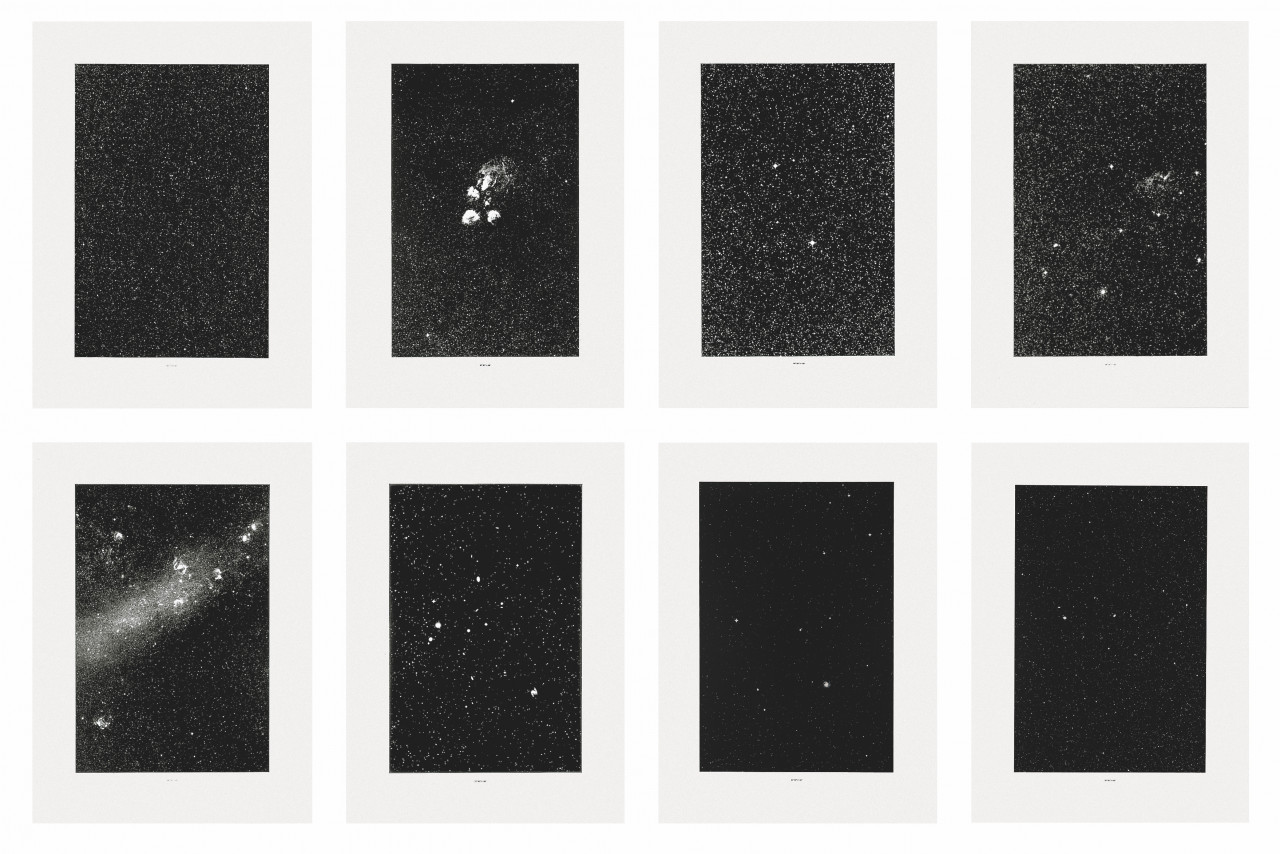
Stars | As a schoolboy, Ruff was as fascinated by astronomy as he was by photography. To him, it therefore seemed only logical to turn the nocturnal sky into the theme for more or less abstract images that were to consist of a black surface with many white dots. Since he did not see how he would be able to achieve the quality of professional astronomic images with the photographic equipment available to him, he resolved to work with original copies of the 1,212 negatives of the "European Southern Observatory" (ESO) archive. The archive houses a collection of scientific images of the firmament in the southern hemisphere taken using a special telescope in the Andes. Ruff chose sections from these negatives (sized 29 x 29 cm) that he defined according to six different categories.
1989
Suite of five dye-transfer photographs, each 45 x 55 cm. Edition of 12, each signed and numbered on verso.
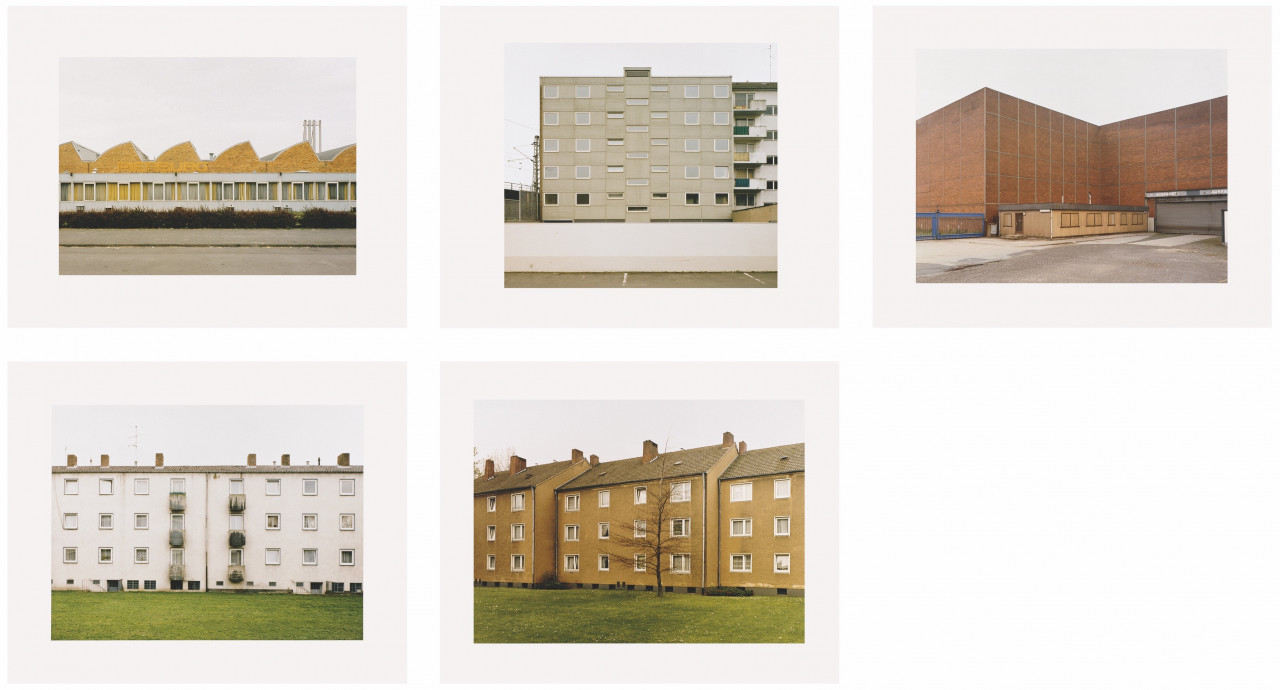
Houses | The experience Ruff had gained making the Portrait series prompted him to return to a pictorial idea he had already concerned himself with when working on the Interiors: exterior shots of buildings. He chose unassuming, trivial buildings from the 1950s to 1970s in and around Düsseldorf. In order to be able to work without being disturbed, he took the images in the early morning and as a rule between January and March. During those months, the sky in Central Europe tends to be a uniform grey that provided the desired neutral background. When structuring the shots, Ruff took his cue from the matter-of-fact approach of Bauhaus photography and the architectural photography of the 1950s-70s, which he knew from postcards and the architectural books of that period. In order to adapt his images to the initial pictorial idea, he retouched two of the photographs (Häu 01, Häu 08) in line with the principle of "retouch as much as necessary and as little as possible."
Suite of five dye-transfer photographs, each 37 x 30 cm. Edition of 12, each signed and numbered on verso.

Portraits | Around 1980, Thomas Ruff began to concern himself for the first time with the genre of "portraits"; it was a type of image that had, at the time, as good as vanished from the art of the day. Alongside portrait work for the Düsseldorf-based band EKG (Ruff was its Art Director), he experimented with the various opportunities portraits offered and made an intensive study of "portrait" as a genre. In the end, he chose a neutral image of the face and upper torso that emphasised the portrayed person's facial features and avoided any psychologising interpretation. The idea was to photograph each person as if she or he were a plaster bust, because, according to Ruff, a photograph only reproduces the surface of things anyway. The portraits were taken with the sitters wearing their everyday clothes and with a calm and serious look on their faces. Any form of emotional involvement such as smiles, grins, or flirting with the camera was eschewed. Ruff intuitively chose as models for the portraits persons he actually knew: friends and acquaintances of his own age whom he had met at the academy or in Düsseldorf's nightlife (on "Ratinger Strasse").
1988
Suite of three dye-transfer photographs, 50 x 40 cm (19½ x 15¾ in) each. Edition of 12, each signed and numbered on verso.
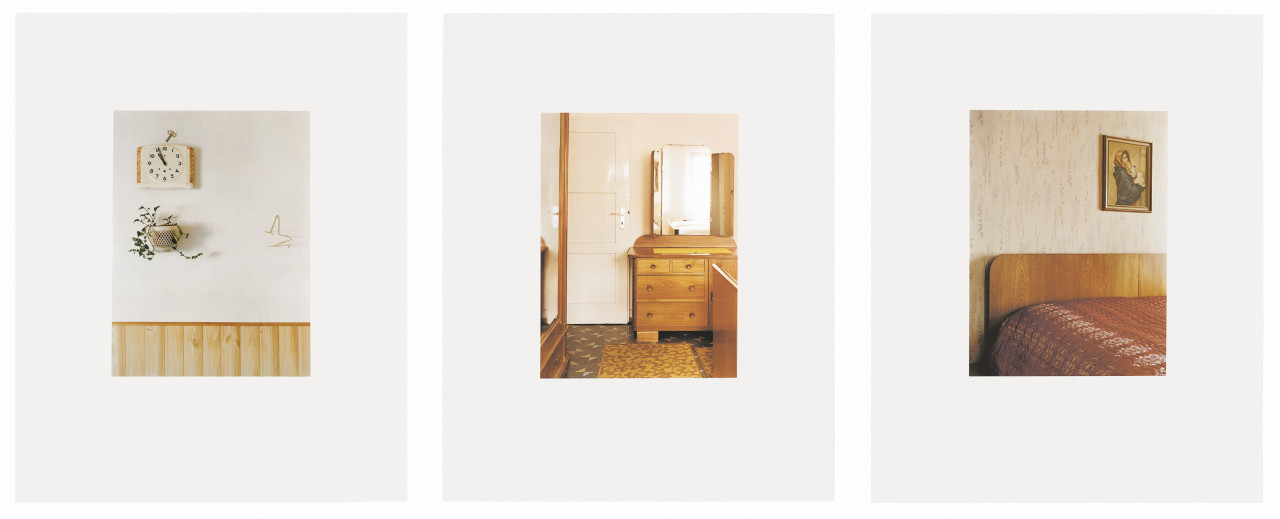
Interiors | Fascinated by photographs by Eugène Atget and Walker Evans, which Thomas Ruff became acquainted with through Bernd Becher, he decided to create photographic studies of the domestic world in which his own generation had grown up and lived. Alongside detailed shots of his own apartment in Düsseldorf taken during countless trips to see his family in the Black Forest, he photographed various interiors that he had known since his youth: rooms in his parent's house, in relatives' apartments, and in the homes of the parents of some of his friends from school. He later expanded the locations chosen to include interiors that corresponded to those encountered in the Black Forest and which he discovered visiting friends and acquaintances.
He set himself the goal of creating images that would show what was characteristic about these rooms. On the one hand, each photo was meant to be as factual as possible and to reproduce the details of the room in a distant manner; on the other hand, the choice of cropping was intended to summarise the room's atmosphere and character as its essence, as it were. For this reason, Ruff often photographed the views exactly as he found them – with the existing natural light and without changing the furnishings in any way. The artist discontinued the series in 1983 since most of the apartments belonging to his relatives and acquaintances were modernised in the early 1980s and brought into line with the style of the day.
